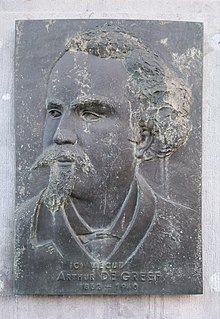|
Arthur De Greef (composer) Arthur De Greef (10 October 1862 – 29 August 1940) was a Belgian classical pianist and composer of the romantic era. Life and careerBorn in Louvain, he won first prize in a local music competition at the age of 11 and subsequently enrolled at the Brussels Conservatoire. His main teacher there was Louis Brassin, a former pupil of Ignaz Moscheles, although he also took lessons from other staffers at the institution, including Joseph Dupont, François-Auguste Gevaert and Fernand Kufferath.[1] After graduating with high distinction from the Conservatoire at the age of 17, De Greef went to Weimar to complete his studies under Franz Liszt. He was a pupil of Liszt for two years.[2] Following the Weimar sojourn, De Greef embarked on a career as a concert pianist, travelling widely. He was a friend of Edvard Grieg, whose Piano Concerto he had played publicly in 1898, and who called him "the best performer of my music I have met with". In addition, he enjoyed the endorsement of Camille Saint-Saëns. British critic Jonathan Woolf has written: "De Greef was, in all respects, an intensely musical, non-sensationalist, eloquent and impressive musician and whilst not being averse to some of the interventionist tactics of his contemporaries (retouching of the score) remained sympathetically self-effacing".[2] De Greef composed a sizeable quantity of music, virtually all of which is now unknown. Among his works are two piano concertos. He was a devoted teacher, and taught piano at the Brussels Conservatoire for many years.[2] Honours
Selected compositionsOrchestral
Concertante works
Chamber music
Piano
RecordingsHis was the first complete recording of Grieg's Piano Concerto in A minor, but he had earlier recorded a cut version. He also recorded with Isolde Menges.[5] Other recorded works included:
A complete discography can be found at Earthlink here. External linksReferences
|